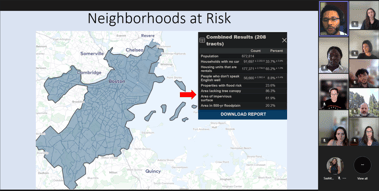.png?width=436&height=352&name=MicrosoftTeams-image%20(31).png)

Guest Post by Nathan Abreu-Cruz, KLA Summer 2023 Climate Analysis Intern.
Nathan is a recent graduate of Clark University, where he studied Environmental Science, with a specialization in Earth System Science.
Climate change resilience is the ability to withstand the effects of climate change. Resilience metrics allow us to track our progress in attaining greater climate resiliency, by giving us a sense of what “successful” climate change adaptation looks like.
There is a wide range of metrics that a community can track to measure the progress of climate action. Throughout my work at KLA, I've learned that picking the right metrics and targets for each community is critical in forming climate action plans that are well-fit to the municipalities they serve.
Identifying Resilience Metrics
During my time at KLA, I worked on a number of projects. A major one was identifying effective resilience metrics and targets for tracking climate risk and benefits. My objective was to create a template that informs the creation of KLA climate action plans designed for communities to meet their sustainability goals. This information empowers communities to assess the impact of their climate actions and track progress toward said goals.

Images from Nathan's final intern project presentation to KLA Staff
Resilience Metric examples:
- Residential gallons per capita day, by year - High water use increases the energy expended for distribution, treatment, purification, and delivery of water. Actions such as education opportunities and technology changes allow for significant water use reduction.
- % area of green space - Green space refers to vegetated areas of open space in urban communities. They yield environmental benefits such as cooling, carbon capture, and pollutant removal, while also improving mental health by providing people with more connections to nature and fostering community.
In the face of geographic limitations and existing conditions, not every metric is applicable to all communities. However, the distribution of metrics amongst different areas of focus provides opportunities for communities to take action in each area.
The areas of focus are:
- Energy Resilience
- Infrastructural Resilience
- Community Health/Preparedness
- Natural Resources
Selecting Metrics
In selecting metrics for this project, I needed to keep several considerations and questions in mind, such as:
- Is the metric applicable at the community scale?
- Is the metric’s data commonly available for communities?
- Is the data updated regularly?
There are many metrics to track resiliency, but I sought out those able to place power in the hands of individual communities. This called for reliable data that communities themselves can access and center their goals around. In the case of metrics that lacked such data, I thought about how communities could obtain the data for themselves. For example, while the EPA publicly shares statistics concerning the national population living near superfund (contaminated) sites, the community scale level is a different matter. But this is still an extremely useful metric to track, and with the help of experts in GIS mapping, communities can obtain this information.
Target Setting
The process of tracking adaptation becomes more complicated when setting targets for the selected metrics, as there are nuances to consider with each metric. For example, a community shouldn’t simply aim to increase tree cover as much as they can. Aside from being a vague goal, tree planting requires a strategic process.
From a social lens, equitable distribution of planting is key in accounting for communities and areas with less tree cover. Thinking environmentally, increased wildfire risk is a real concern when setting tree planting goals. Now it’s no longer a question of “how many trees can we plant?”, but rather “what is the best way for us to plant trees in a way that addresses the community’s needs?”
Furthermore, no community starts out in the same place. One community might be closer to achieving a target than another. Maybe the community has even already met or exceeded the target. Therefore, blanket targets are of little use. For this reason, I provided alternative targets for metrics as needed. In the process of navigating barriers like this, I came to understand that setting a target for a simple metric such as “aim to increase tree cover”, isn’t all that simple.
Personal Conclusions
With climate change, time is of the essence. In taking action and setting targets, outlining a timeframe is just as important as deciding what to do, so we can ensure we are on track to achieve our goals. This is why we see common near future “deadlines” such as 2025, 2030, or 2050 in climate action documents and reports.
In this regard, I’m happy to have had the chance to apply my research to the development of a New England community’s action plan. In adjusting the base targets to account for goals in 10-year intervals and the community’s specific needs, I learned exactly how my project can be put to use. As a recent grad, I’ve done a fair amount of environmental research and writing over the years, but my time at KLA has allowed me to apply these skills in a wider context that I can witness the results of firsthand.
Through this resilience metric project, I gained a better understanding of what goes into the formation of climate action plans and goals. I particularly enjoyed learning about how different communities approach the same kind of problems and transform these grand climate goals into reality. This transformation is a multi-step process that calls for contributions from all sorts of people and organizations. It has been a rewarding experience, not only in highlighting how daunting problems are broken down into more manageable pieces, but in emphasizing what people can accomplish when working with others.
--
Read our other 2023 KLA Summer Interns' blogs here:
Dunia Seidu, Climate Storytelling Intern: Cambridge Leads Building Decarbonization with BlocPower Partnership
Saahithi Achanta: How Can Climate Communication Drive Behavior Change?


